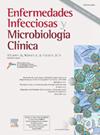COVID-19相关性肺曲霉病(CAPA)对重症COVID-19患者预后的影响:西班牙南部某二级医院临床特点及危险因素
IF 2.5
4区 医学
Q3 INFECTIOUS DISEASES
Enfermedades infecciosas y microbiologia clinica
Pub Date : 2025-10-01
DOI:10.1016/j.eimc.2024.08.007
引用次数: 0
摘要
sars - cov -2感染患者面临包括真菌感染在内的感染性并发症。covid -19相关肺曲霉病(CAPA)与SARS-CoV-2损伤、皮质类固醇和肺部疾病有关。诊断的不确定性持续存在,本研究旨在为CAPA的危险因素、诊断和预后提供证据。方法对某二级医院2020年3月至2022年12月新冠肺炎重症CAPA患者进行回顾性病例对照研究。变量包括人口统计学和病史、感染过程、治疗、并发症和结局。结果共收集CAPA病例27例,对照组56例。考虑到适应标准,CAPA患病率为5.1%。CAPA病例与心血管危险因素、自身免疫性疾病、慢性皮质类固醇治疗和其他免疫抑制剂、RRT、ECMO、皮质类固醇累积剂量、直接入住ICU和有创机械通气相关。他们表现出更高的RALE和APACHE-II评分,直接进入ICU,更多的有创通气支持。CAPA患者在120天死亡风险较高。CAPA评分在预测CAPA风险方面具有敏感性和特异性。结论病例120天死亡率高(67%)。经典的危险因素和其他新的危险因素,如使用ECMO、自身免疫性疾病或直接进入ICU,已经被假设。类固醇累积剂量(800 mg甲替强的松龙)是发生CAPA的关键危险因素之一。尽管还需要更多的研究,但CAPA评分是确定哪些患者应该密切监测的有用工具。本文章由计算机程序翻译,如有差异,请以英文原文为准。
Effects of COVID-19-Associated Pulmonary Aspergillosis (CAPA) on the prognosis of severe COVID-19: Clinical characteristics and risk factors in a second-level hospital from Southern Spain
Introduction
SARS-CoV-2 infection patients face infectious complications, including fungal infections. COVID-19-Associated Pulmonary Aspergillosis (CAPA) is linked to SARS-CoV-2 damage, corticosteroids, and pulmonary diseases. Diagnostic uncertainties persist, and this study aims to contribute evidence on CAPA risk factors, diagnostics, and prognosis.
Methods
A retrospective case–control study focused on critically ill COVID-19 patients with CAPA between March 2020 and December 2022 in a second-level hospital. Variables included demographic and medical history, infection course, treatments, complications, and outcomes.
Results
27 CAPA cases and 56 controls were collected. CAPA prevalence was 5.1% considering adapted criteria. CAPA cases were associated with cardiovascular risk factors, autoimmune diseases, chronic corticosteroid therapy, and other immunosuppressants, RRT, ECMO, cumulative corticosteroid dose, direct ICU admission, and invasive mechanical ventilation. They exhibited higher RALE and APACHE-II scores, direct ICU admission, and more invasive ventilatory support. CAPA patients had a higher risk of mortality at 120 days. The CAPA score demonstrated sensitivity and specificity in predicting CAPA risk.
Conclusions
There is a high mortality rate at 120 days among cases (67%). Classical risk factors and other new ones, such as the use of ECMO, autoimmune diseases, or direct admission to the ICU, have been postulated. The accumulated dose of steroids (>800 mg of metilprednisolone) is one of the key risk factors in the development of CAPA. The CAPA score is a useful tool to define which patients should be monitored closely, although more studies are still needed.
求助全文
通过发布文献求助,成功后即可免费获取论文全文。
去求助
来源期刊
CiteScore
2.10
自引率
8.00%
发文量
194
审稿时长
29 days
期刊介绍:
Hoy está universalmente reconocida la renovada y creciente importancia de la patología infecciosa: aparición de nuevos agentes patógenos, de cepas resistentes, de procesos con expresión clínica hasta ahora desconocida, de cuadros de una gran complejidad. Paralelamente, la Microbiología y la Infectología Clínicas han experimentado un gran desarrollo como respuesta al reto planteado por la actual patología infecciosa. Enfermedades Infecciosas y Microbiología Clínica es la Publicación Oficial de la Sociedad Española SEIMC. Cumple con la garantía científica de esta Sociedad, la doble función de difundir trabajos de investigación, tanto clínicos como microbiológicos, referidos a la patología infecciosa, y contribuye a la formación continuada de los interesados en aquella patología mediante artículos orientados a ese fin y elaborados por autores de la mayor calificación invitados por la revista.

 求助内容:
求助内容: 应助结果提醒方式:
应助结果提醒方式:


